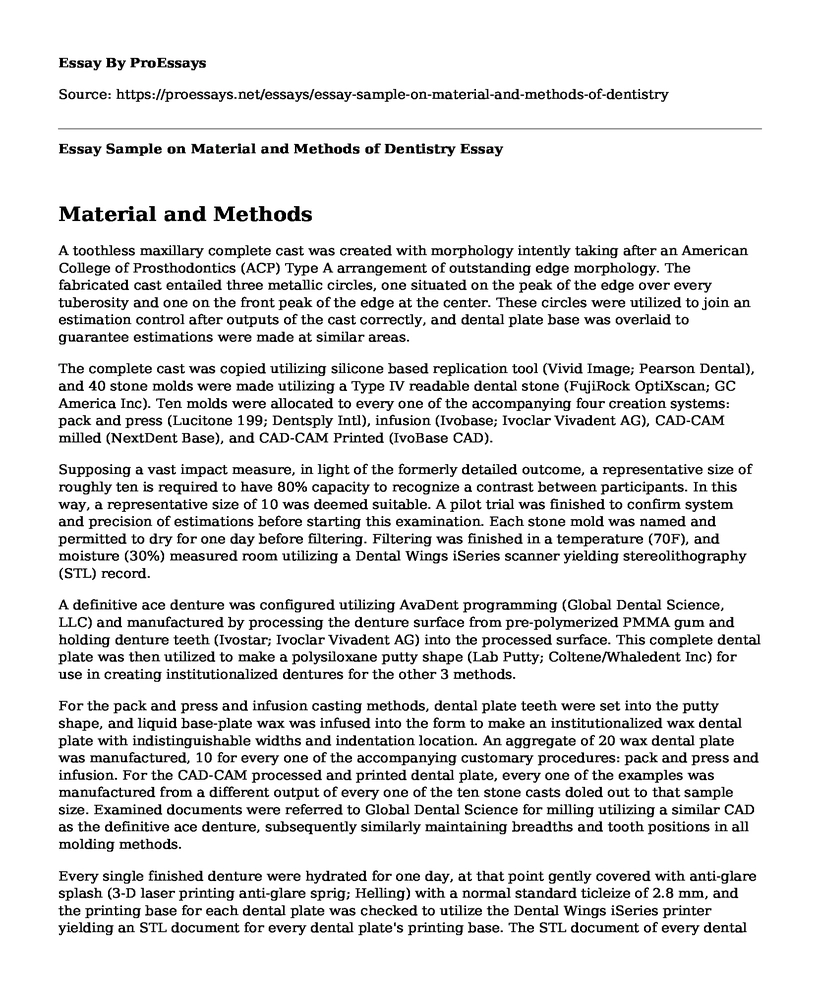Material and Methods
A toothless maxillary complete cast was created with morphology intently taking after an American College of Prosthodontics (ACP) Type A arrangement of outstanding edge morphology. The fabricated cast entailed three metallic circles, one situated on the peak of the edge over every tuberosity and one on the front peak of the edge at the center. These circles were utilized to join an estimation control after outputs of the cast correctly, and dental plate base was overlaid to guarantee estimations were made at similar areas.
The complete cast was copied utilizing silicone based replication tool (Vivid Image; Pearson Dental), and 40 stone molds were made utilizing a Type IV readable dental stone (FujiRock OptiXscan; GC America Inc). Ten molds were allocated to every one of the accompanying four creation systems: pack and press (Lucitone 199; Dentsply Intl), infusion (Ivobase; Ivoclar Vivadent AG), CAD-CAM milled (NextDent Base), and CAD-CAM Printed (IvoBase CAD).
Supposing a vast impact measure, in light of the formerly detailed outcome, a representative size of roughly ten is required to have 80% capacity to recognize a contrast between participants. In this way, a representative size of 10 was deemed suitable. A pilot trial was finished to confirm system and precision of estimations before starting this examination. Each stone mold was named and permitted to dry for one day before filtering. Filtering was finished in a temperature (70F), and moisture (30%) measured room utilizing a Dental Wings iSeries scanner yielding stereolithography (STL) record.
A definitive ace denture was configured utilizing AvaDent programming (Global Dental Science, LLC) and manufactured by processing the denture surface from pre-polymerized PMMA gum and holding denture teeth (Ivostar; Ivoclar Vivadent AG) into the processed surface. This complete dental plate was then utilized to make a polysiloxane putty shape (Lab Putty; Coltene/Whaledent Inc) for use in creating institutionalized dentures for the other 3 methods.
For the pack and press and infusion casting methods, dental plate teeth were set into the putty shape, and liquid base-plate wax was infused into the form to make an institutionalized wax dental plate with indistinguishable widths and indentation location. An aggregate of 20 wax dental plate was manufactured, 10 for every one of the accompanying customary procedures: pack and press and infusion. For the CAD-CAM processed and printed dental plate, every one of the examples was manufactured from a different output of every one of the ten stone casts doled out to that sample size. Examined documents were referred to Global Dental Science for milling utilizing a similar CAD as the definitive ace denture, subsequently similarly maintaining breadths and tooth positions in all molding methods.
Every single finished denture were hydrated for one day, at that point gently covered with anti-glare splash (3-D laser printing anti-glare sprig; Helling) with a normal standard ticleize of 2.8 mm, and the printing base for each dental plate was checked to utilize the Dental Wings iSeries printer yielding an STL document for every dental plate's printing base. The STL document of every dental plate was covered on the STL record of the relating pre-preparing cast utilizing surface coordinating programming (Geo-enchantment Regulator 2014; 3D Frameworks). Utilizing this application, estimations were established at 60 for every one of the 40 dental plates utilizing an overlap manual for approving the area of the 60 estimations. Moreover, color surface charts were made to outwardly show the adjustment of the denture base embedded in the mold. The base coordinating and estimations gave the premise to the assessment of fit inconsistencies in the accompanying zones: the peak of the dental plate outskirt, 6 mm from dental plate fringe, the peak of the edge, sense of taste, and back palatal seal.
To decide if the variations between each fabricating method were empirically noteworthy, the Kruskall-Wallis investigation of difference was directed. This investigation looked at every one of the fabricating method estimations by area and decided if the thing that matters was critical. The standard mistake of revised approximations was 0.002 mm.
An inspection of average positions of misrepresentation among the fabricating strategies layered by the five areas of intrigue was directed utilizing the Kruskal-Wallis technique. Post hoc analyses were balanced for various analyses. Measurable inspection utilizing the Levene test was utilized to decide if the similarity and difference occurred in the fabricating methods. All trial of theories were 2-faced (a=.05).
Cite this page
Essay Sample on Material and Methods of Dentistry. (2022, Nov 01). Retrieved from https://proessays.net/essays/essay-sample-on-material-and-methods-of-dentistry
If you are the original author of this essay and no longer wish to have it published on the ProEssays website, please click below to request its removal:
- Paper Example on Merck Company and River Blindness
- The Role of NFIP in Emergency Management at the Federal Level
- Essay Sample on Teenage Pregnancy: A Journey of Pain, Anger and Resentment
- Essay Sample on Kidney Stones: Distinguishing Symptoms, Diagnosis, & Treatment
- Essay Example on Nursing: Defining and Expounding Its Vital Role in Healthcare
- Nurse Practice Act: Permitting Linda to Work in ICU & Professional Negligence - Essay Sample
- Free Essay Example on Addressing Nursing Shortage: Educational Background, Expertise







